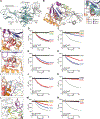Bacterial esterases reverse lipopolysaccharide ubiquitylation to block host immunity
- PMID: 38870903
- PMCID: PMC11271751
- DOI: 10.1016/j.chom.2024.04.012
Bacterial esterases reverse lipopolysaccharide ubiquitylation to block host immunity
Abstract
Aspects of how Burkholderia escape the host's intrinsic immune response to replicate in the cell cytosol remain enigmatic. Here, we show that Burkholderia has evolved two mechanisms to block the activity of Ring finger protein 213 (RNF213)-mediated non-canonical ubiquitylation of bacterial lipopolysaccharide (LPS), thereby preventing the initiation of antibacterial autophagy. First, Burkholderia's polysaccharide capsule blocks RNF213 association with bacteria and second, the Burkholderia deubiquitylase (DUB), TssM, directly reverses the activity of RNF213 through a previously unrecognized esterase activity. Structural analysis provides insight into the molecular basis of TssM esterase activity, allowing it to be uncoupled from its isopeptidase function. Furthermore, a putative TssM homolog also displays esterase activity and removes ubiquitin from LPS, establishing this as a virulence mechanism. Of note, we also find that additional immune-evasion mechanisms exist, revealing that overcoming this arm of the host's immune response is critical to the pathogen.
Keywords: Autophagy; Burkholderia; RNF213; TssM; Ubiquitin esterase; bacterial effector; cell-autonomous immunity; non-canonical ubiquitylation.
Copyright © 2024 The Authors. Published by Elsevier Inc. All rights reserved.
Conflict of interest statement
Declaration of interests The authors declare no competing interests.
Figures






Update of
-
Dedicated bacterial esterases reverse lipopolysaccharide ubiquitylation to block immune sensing.Res Sq [Preprint]. 2023 Jul 12:rs.3.rs-2986327. doi: 10.21203/rs.3.rs-2986327/v1. Res Sq. 2023. Update in: Cell Host Microbe. 2024 Jun 12;32(6):913-924.e7. doi: 10.1016/j.chom.2024.04.012. PMID: 37503018 Free PMC article. Updated. Preprint.
References
-
- Walsh SC, Reitano JR, Dickinson MS, Kutsch M, Hernandez D, Barnes AB, Schott BH, Wang L, Ko DC, Kim SY, et al. (2022). The bacterial effector GarD shields Chlamydia trachomatis inclusions from RNF213-mediated ubiquitylation and destruction. Cell Host Microbe 30, 1671–1684.e9. 10.1016/j.chom.2022.08.008. - DOI - PMC - PubMed
MeSH terms
Substances
Grants and funding
LinkOut - more resources
Full Text Sources

